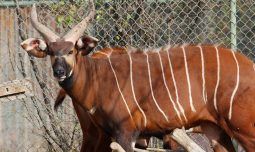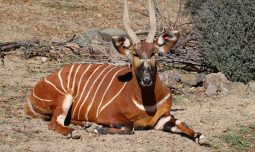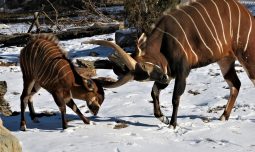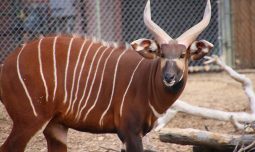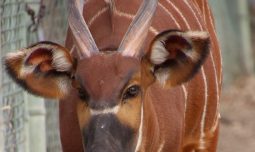Classification
Class Mammalia
Order Artiodactyla
Family Bovidae
Genus Tragelaphus
Species eurycerus
Subspecies isaaci
Habitat & Range
Bongo are only found in montane rain forests with dense undergrowth. They thrive at the forest edge and in new growth areas that occur after disturbances.
Eastern (or mountain) bongos are much less prevalent than the western bongo and are only found in a mountain forested region of central Kenya – near Mt. Kenya and the Aberdare mountains.

Eastern Bongo
Tragelaphus eurycerus isaaci
Bongos have many adaptations that help them survive in the wild. The markings on the sides and backs of a bongo camouflage them in forest shadows. Their large ears help them hear approaching predators. When running from a predator, they do so with their head up and back, so their horns do not catch in the dense forest trees and plants.
Adaptations
- They are mainly nocturnal but also graze during the morning and evening (crepuscular).
- They are very shy and reclusive. When disturbed they run at full speed through the thick undergrowth to seek cover. They will then stand with their back to the disturbance to be in a good position to flee, and their back is less conspicuous.
- They run with their head up so the horns lie along the back and do not impede their flight in the forest; the horns may even help deflect branches.
- The stripes provide added camouflage from predators when they are in the forest.
- They rely less on scent than other antelopes because they have no special secretion glands.
- The red fur pigment stains the undergrowth when they brush against it. Although helpful for finding each other, it also assists predators.
- The large ears help provide sharp hearing – a good adaptation for forest dwellers.
Physical Description
- They are one of the largest forest antelopes. At full maturity, they stand between 3.5 to 4.5 ft (1–1.4m) high at the shoulder, are 7-10 ft (2-3m) long, and weigh between 460 and 900 lbs (200-408kg), with males being heavier than females; eastern bongos are larger than western bongos.
- Bongos have a red-brown chestnut coat with 10-15 narrow vertical white stripes running over the back and down the sides and a single chest stripe. They have white underparts. The front legs are blackish with thick white stripes or spots and there is a white crescent above the hooves on all four legs. Males are darker than females.
- The face has a black muzzle with a white chevron under the eyes and there are 1 or 2 white cheek patches on either side of the face. The ears are large with some white spotting.
- Both sexes have lyre shaped smooth horns with 1 to 1.5 turns. The horns can grow to 2.5 ft long. They are hollow and are made out of keratin.
- The tail is long and tufted at the tip.
Diet
What Does It Eat?
In the wild: Leaves and bark from bushes along with grasses, flowers and roots. They require salt in their diet and will often visit mineral licks at night
At the zoo: A variety of grain, browse, alfalfa, fruit and vegetables
What Eats It?
They are hunted by leopards and sometimes hyenas and lions but humans are now the main predators.
Social Organization
Although adult males of a similar size or age seem to be solitary, younger males may join with an older male temporarily. Males are relatively non-territorial and, although serious male fights may occur, males will try to avoid these by visually displaying or resorting to ritualized sparring. Visual displays include neck bulging, eye rolling and holding horns in a vertical position while slowly pacing back and forth in front of the other male. Males only seek out females at mating time and, when with female herds, do not restrict movement of the females (unlike other antelope). Females usually stay in herds of 6-8 individuals and young - the herds may have been larger in the past.
Life Cycle
Bongo births are concentrated in discreet traditional calving grounds. They bear a single calf after a gestation period of about 9.5 months. To limit predation, calves are hidden in the undergrowth, with the mother visiting for short periods to allow the calf to nurse. After about 1-2 weeks, the calf is able to join the herd and is weaned after about 6 months. Eastern bongo males possibly live up to 9 years in the wild and females 12 years - but data is scarce. They can live about 19-21 years in managed care.
Collection Connection
- Denver Zoo has 8 Eastern bongos:
- Fern was born 3/12/16. She has 2 large white patches on her cheeks.
- Columbine was born 4/20/15, and was named in commemoration of the Columbine school shooting. She has 1 larger white cheek patch.
- Howard was born on 8/9/16 and is the only adult male. He is much darker and larger.
- Fennel - a female, was born 6/6/2020
- Felix - a male, was born 4/10/2021
- Clover - a female, was born 4/29/2021
- Winston - a male, was born 3/5/2022
- Doug - a male, was born 3/16/2022
- Denver Zoo bongos can be found in the Central Ranges area between Predator Ridge and Toyota Elephant Passage.
Conservation Status
IUCN Status: Critically Endangered
Humans activities, such as hunting for bush meat or sport, deforestation and habitat fragmentation have contributed to the sharp decline of this species. It is estimated there are less than 200 in the wild, with an imminent danger of extinction despite surveillance and reintroduction from captive breeding programs. There are more individuals in zoos than in the wild.

Download the App!
Get the FREE Denver Zoo app today, and be a pro the next time you visit the Zoo. You’ll get access to the Zoo map, daily activities and schedules, animal facts, and more. You can even load your membership card onto the app for additional convenience. It puts everything you need for an amazing Zoo experience right into the palm of your hand!
